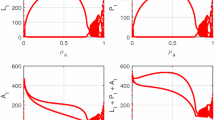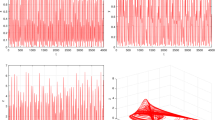Abstract
The structured population LPA model is studied. The model describes flour beetle (Tribolium) population dynamics of four stage populations: eggs, larvae, pupae and adults with cannibalism between these stages. We concentrate on the case of non-zero cannibalistic rates of adults on eggs and adults on pupae and no cannibalism of larvae on eggs, but the results can be numerically continued to non-zero cannibalism of larvae on eggs. In this article two-parameter bifurcations in LPA model are analysed. Various stable and unstable invariant sets are found, different types of hysteresis are presented and abrupt changes in dynamics are simulated to explain the complicated way the system behaves near two-parameter bifurcation manifolds. The connections between strong 1:2 resonance and Chenciner bifurcations are presented as well as their very significant consequences to the dynamics of the Tribolium population. The hysteresis phenomena described is a generic phenomenon nearby the Chenciner bifurcation or the cusp bifurcation of the loop.
Similar content being viewed by others
Notes
In the case where \(c_{EL} \ne 0\) the flip bifurcation manifold depends on cannibalism rates.
Non-degeneracy and transversality conditions should be involved for each bifurcation for correct analysis. It can be done analytically using the reduction to the center manifold. We used program MactontM (see e.g. Kuznetsov 2013) to get numerical results, because we do not continue with any further analysis of codimension 3 bifurcations.
The Chenciner bifurcation is an analogy of continuous Bautin (or generalized Hopf) bifurcation.
Fold bifurcation of a fixed point gives rise to two fixed points with opposite stability, fold bifurcation of a cycle gives rise to two cycles with opposite stability, for more details see Kuznetsov (1998).
Topologically equivalent diagram is obtained for small \(c_{EL}>0\).
The bifurcation diagram for the Chenciner bifurcation is presented and explained in total in the Sect. 4.1. Comparing Fig. 5 and \(\textcircled {{2}}\) we obtain the correspondence of domain II. In Fig. 5 to type \(\textcircled {{1}}\) in Fig. 2 and correspondence between domain III. in Fig. 5 and type \(\textcircled {{3}}\) in Fig. 2.
References
Chenciner A (1987) Bifurcations de points fixes elliptiques. III. Orbites périodiques de “petites” périodes et élimination résonnante des couples de courbes invariantes, Inst. Hautes Études Sci. Publ Math 66:5–91
Costantino RF, Desharnais RA, Cushing JM, Dennis B (1997) Chaotic dynamics in an insect population. Science 275(5298):389–391
Cushing JM (1998) An introduction to structured population dynamics. Society for Industrial and Applied Mathematics, Philadelphia
Cushing JM (2003) Chaos in ecology: experimental nonlinear dynamics. Academic Press, Amsterdam
Cushing JM, Constantino RF, Dennis B, Desharnais RA, Henson SM (1998) Nonlinear population dynamics: models, experiments and data. J Theor Biol 194(1):1–9
Cushing JM, Henson SM, Desharnais RA, Dennis B, Costantino RF, King A (2001) A chaotic attractor in ecology: theory and experimental data. Chaos Solitons Fractals 12(2):219–234
Dennis B, Desharnais RA, Cushing JM, Constantino RF (1995) Nonlinear demographic dynamics: mathematical models, statistical methods, and biological experiments. Ecol Monogr 65(3):261–282
Dennis B, Desharnais RA, Cushing JM, Costantino RF (1997) Transitions in population dynamics: equilibria to periodic cycles to aperiodic cycles. J Anim Ecol 66(5):704–729
Elaydi S (2005) An introduction to difference equations, 3rd edn. Springer, New York
Izhikevich EM (2007) Dynamical systems in neuroscience. MIT press, Cambridge
Kuang Y, Cushing JM (2007) Global stability in a nonlinear difference-delay equation model of flour beetle population growth. J Differ Equ Appl 2(1):31–37
Kuznetsov YA (1998) Elements of applied bifurcation theory, 2nd edn. Springer, New York
Kuznetsov YA (2013) A Tutorial for MatcontM GUI. Utretcht University, Utrecht
Ludwig D, Jones DD, Holling CS (1978) Qualitative analysis of insect outbreak systems: the spruce budworm and forest. J Anim Ecol 47:315–332
Melbourne BA, Hastings A (2008) Extinction risk depends strongly on factors contributing to stochasticity. Nature 454(7200):100–103
Schreiber S, Rudolf VHW (2008) Crossing habitat boundaries: coupling dynamics of ecosystems through complex life cycles. Ecol Lett 11(6):576–587
Author information
Authors and Affiliations
Corresponding author
Rights and permissions
About this article
Cite this article
Hajnová, V., Přibylová, L. Two-parameter bifurcations in LPA model. J. Math. Biol. 75, 1235–1251 (2017). https://doi.org/10.1007/s00285-017-1115-8
Received:
Revised:
Published:
Issue Date:
DOI: https://doi.org/10.1007/s00285-017-1115-8













